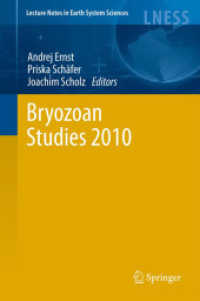- ホーム
- > 洋書
- > 英文書
- > Science / Mathematics
Full Description
Those who work in allied health professions and education aim to make people's lives better. Often, however, it is hard to know how effective this work has been: would change have occurred if there was no intervention? Is it possible we are doing more harm than good? To answer these questions and develop a body of knowledge about what works, we need to evaluate interventions. Objective intervention research is vital to improve outcomes, but this is a complex area, where it is all too easy to misinterpret evidence. This book uses practical examples to increase awareness of the numerous sources of bias that can lead to mistaken conclusions when evaluating interventions. The focus is on quantitative research methods, and exploration of the reasons why those both receiving and implementing intervention behave in the ways they do. Evaluating What Works: Intuitive Guide to Intervention Research for Practitioners illustrates how different research designs can overcome these issues, and points the reader to sources with more in-depth information. This book is intended for those with little or no background in statistics, to give them the confidence to approach statistics in published literature with a more critical eye, recognise when more specialist advice is needed, and give them the ability to communicate more effectively with statisticians.
Key Features:
Strong focus on quantitative research methods
Complements more technical introductions to statistics
Provides a good explanation of how quantitative studies are designed, and what biases and pitfalls they can involve
Contents
1. Introduction 2. Why observational studies can be misleading 3. How to select an outcome measure 4. Improvement due to nonspecific effects of intervention 5. Limitations of the pre-post design: biases related to systematic change 6. Estimating unwanted effects with a control group 7. Controlling for selection bias: randomized assignment to intervention 8. The researcher as a source of bias 9. Further potential for bias: volunteers, dropouts, and missing data 10. The randomized controlled trial as a method for controlling biases 11. The importance of variation 12. Analysis of a two-group RCT 13. How big a sample do I need? Statistical power and type II errors 14. False positives, p-hacking and multiple comparisons 15. Drawbacks of the two-arm RCT 16. Moderators and mediators of intervention effects 17. Adaptive Designs 18. Cluster Randomized Controlled Trials 19. Cross-over designs 20. Single case designs 21. Can you trust the published literature? 22. Pre-registration and Registered Reports 23. Reviewing the literature before you start 24. Putting it all together 25. Comments on exercises 26. References






